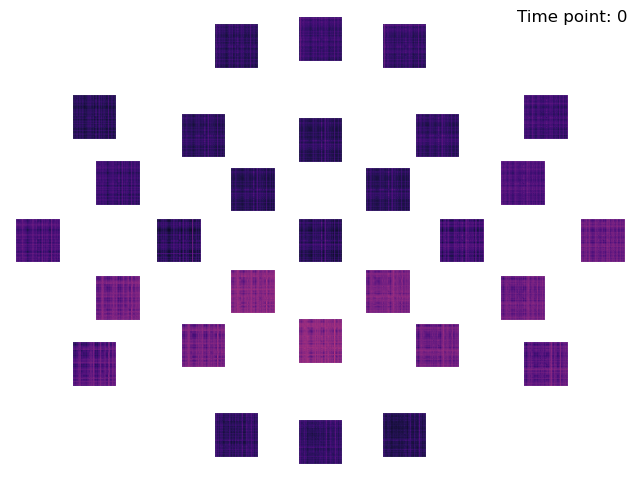Plot sensor-level RDMs
This example demonstrates how to visualize representational dissimilarity matrices
(RDMs) computed from EEG data. We will compute them using a spatial searchlight and plot
the RDM computed for each searchlight-patch.
Authors
Marijn van Vliet <marijn.vanvliet@aalto.fi>
# Import required packages
import numpy as np
import mne
import mne_rsa
MNE-Python contains a build-in data loader for the kiloword dataset. We use it here to
read it as 960 epochs. Each epoch represents the brain response to a single word,
averaged across all the participants. For this example, we speed up the computation,
at a cost of temporal precision, by downsampling the data from the original 250 Hz. to
100 Hz.
Reading C:\Users\wmvan\mne_data\MNE-kiloword-data\kword_metadata-epo.fif ...
Isotrak not found
Found the data of interest:
t = -100.00 ... 920.00 ms
0 CTF compensation matrices available
Adding metadata with 8 columns
960 matching events found
No baseline correction applied
0 projection items activated
We now compute RDMs using a spatial searchlight with a radius of 45 centimeters.
# This will create a generator for the RDMs
rdms = mne_rsa.rdm_epochs(
epochs, # The EEG data
dist_metric="correlation", # Metric to compute the EEG RDMs
spatial_radius=45, # Spatial radius of the searchlight patch
temporal_radius=None, # Perform only spatial searchlight
tmin=0.15,
tmax=0.25, # To save time, only analyze this time interval
)
# Unpack the generator into a NumPy array so we can plot it
rdms = np.array(list(rdms))
# Visualize the RDMs.
mne_rsa.viz.plot_rdms_topo(rdms, epochs.info, cmap="magma")

Creating spatial searchlight patches
<Figure size 640x480 with 29 Axes>
Total running time of the script: (0 minutes 8.431 seconds)
Gallery generated by Sphinx-Gallery
